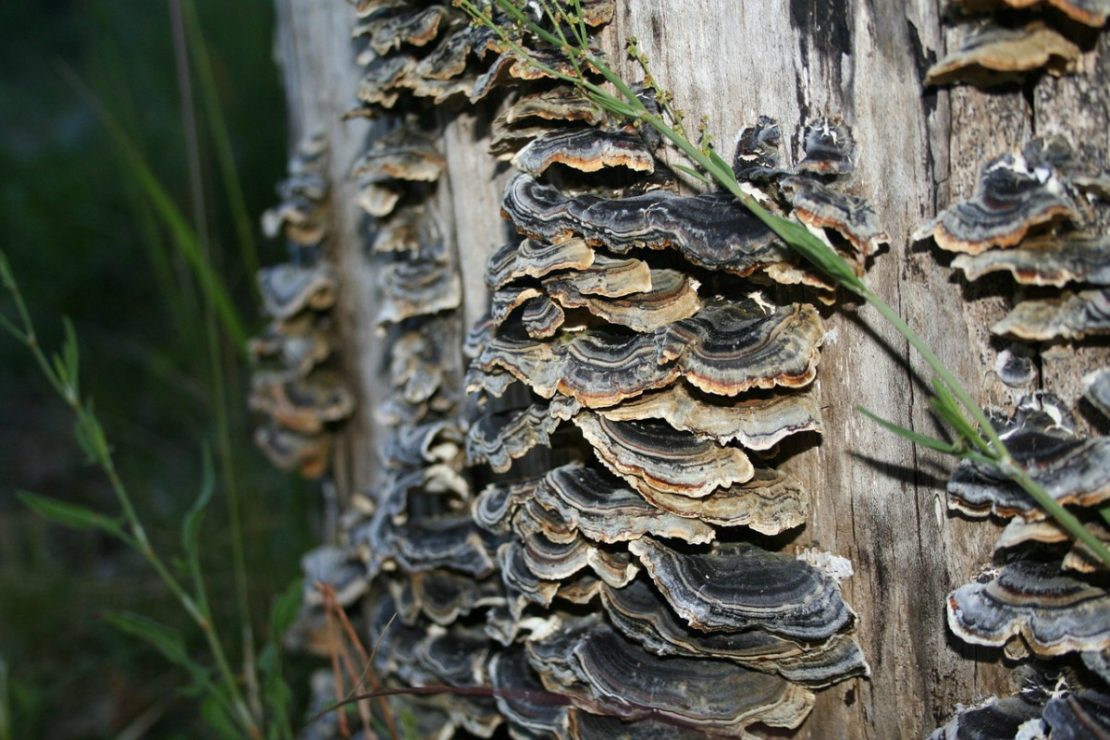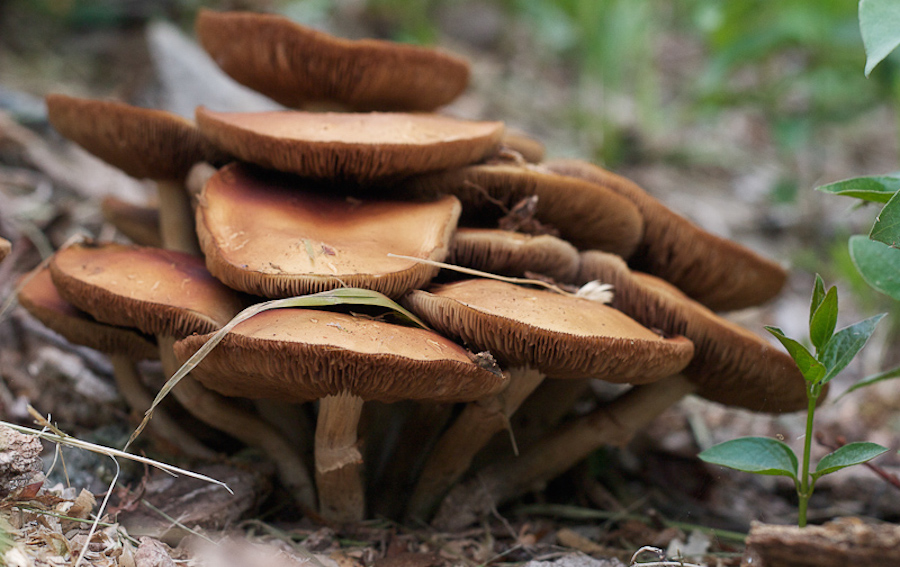
10 Amazing Mushrooms For Wellness (+ Free Mushroom Chart Download)
I live in the mountains of East Tennessee, deep in the southern half of the Appalachian mountain range. My home is surrounded by trees, ferns, and mushrooms, and no matter the season, I feel the pull to venture outdoors into the peaceful forest that waits to be explored.
Here, a vast world of woodland plants and fungi is waiting to be discovered. As I grow into the herbalist I want to become, these woodland plants call to me — to learn about them, to use them, and to share their gifts with others.
In this post, I’d like to take a peek at the world of woodland herbs — more specifically the world of amazing mushrooms that grow in the woods and forests. Mushrooms are an important part of the woodland ecosystem. Not only are they important parts of their habitat, but many mushrooms can also be beneficial to our wellness as well.
The World of Woodland Herbs
Several years ago, my family and I moved deeper into the mountains, and since then, a whole new world of herbs has opened up to me. I’m constantly amazed, and I long to learn more about the plants that live so close to my front door.
There are pines, oaks, and poplars. There’s usnea, ginseng, and cohosh. And then, there are the mushrooms — inedible and edible mushrooms that grow abundantly on the cool, damp forest floor.

Mushrooms For Food & Wellness
Edible mushrooms have always intrigued my husband. When we go on walks through the woods, while I’m busy spotting plants, taking photos of them, and telling our four boys what they are and how to use them, my husband is busy looking for mushrooms.
When he finds a new mushroom, he takes pictures of it with his phone and then looks it up in a mushroom field guide when we get home to see if it’s edible or not.
You see, when my husband looks at a mushroom, he’s thinking about food, but when I look at a mushroom, I’m thinking about wellness.
At first, I could have cared less about eating mushrooms. Instead, I was more interested in knowing if I could use them for wellness purposes in teas, tinctures, and electuaries. However, the more my husband and I learn about mushrooms, the more we find that the two can’t be separated. Eating mushrooms can support wellness just as much as using them in a variety of herbal preparations can.
10 Amazing Mushrooms For Wellness

Did you know that there are 38,000 different species of mushrooms? However, not all of those mushrooms are edible. Some mushrooms are too tough to eat, others will make you sick to your stomach, and a small percentage will kill you. Out of those that are edible, some taste better than others and are more suited to food while others lack flavor but are still great to use for their wellness benefits.
As a novice to mushrooms, I find that the more I research them, the better I understand them, and the more comfortable I am with using mushrooms for wellness. Books, websites, and online foraging or plant identification groups all help me to learn and flesh out the information I seek.
From the research I’ve done as I try to learn more about this huge world of amazing mushrooms, I’m finding that most safe, edible mushrooms have wellness benefits whether you eat them in food or you prepare them as herbal preparations like teas, tinctures, and electuaries.
Free Mushrooms for Wellness Download
 Learn more about these amazing mushrooms and their wellness benefits in this free Mushrooms for Wellness download from the Herbal Academy’s Intermediate Herbal Course. This graphic highlights ten common mushrooms and sums them up into a simple chart that you can print and add to your herbal study notebook or materia medica.
Learn more about these amazing mushrooms and their wellness benefits in this free Mushrooms for Wellness download from the Herbal Academy’s Intermediate Herbal Course. This graphic highlights ten common mushrooms and sums them up into a simple chart that you can print and add to your herbal study notebook or materia medica.
How To Make Herbal Preparations For Mushrooms
As you can see from the above chart, the health benefits of mushrooms come not only from eating mushrooms as food but also by extracting them in various herbal preparations.
When it comes to making herbal preparations from mushrooms, there are several that can be used. The most common way to prepare mushrooms for wellness is to use water-extractions such as teas, infusions, decoctions, syrups, or double-extraction tinctures in order to reap the health benefits of mushrooms.
No matter which herbal preparation you choose, it’s essential that you boil the mushrooms for 45-60 minutes in order to extract the mushroom’s active constituents from inside the cell walls. According to herbalist Christopher Hobbs, heat breaks down chitin, the fibrous part of the mushroom’s structure, and exposes active molecules (Hobbs, 2014). He also states that cooking mushrooms, while certain heat-sensitive nutrients are decreased, other nutrients become more available (Hobbs, 1995).
After cooking for a sufficient amount of time, your liquid should be dark and have a strong smell and taste. Feel free to add flavorful herbs into your mushroom preparations to mask their flavor if you wish. Ginger, cinnamon, clove, and peppermint are several herbs that can really improve the flavor of these preparations.

You can learn more about making these herbal preparations from the following resources:
- How To Make a Perfect Cup of Herbal Tea – Growing Up Herbal
- A Deeper Look At Herbal Infusions – Herbal Academy
- How To Make An Herbal Decoction – Herbal Academy
- How To Make An Herbal Syrup – Herbal Academy
- How To Make A Medicinal Mushroom Double-Extraction Tincture – Herbal Academy
Notes On Dosages For Mushrooms
Like most herbs, dosages for mushrooms will vary. Some mushrooms are suggested to use “ad lib” which means as often or as much as you’d like. These mushrooms tend to be very nourishing and have no known toxicities or upper dosage limits. Other mushrooms have suggested dosages that fall within a certain range per day. Herbalist Christopher Hobbs suggests taking mushroom preparations at a standard dose of 1/2 – 1 teaspoon of tincture for 3-9 months when using them as an overall tonic (Hobbs, 1995).
Another thing to consider when it comes to finding the correct dosage for mushrooms is the reason why you’re using the mushroom in the first place. If you’re using it for general wellness purposes, you probably need less of it than if you’re using it to help support your body through a specific imbalance.
If you have questions regarding dosage for a specific mushroom, your best bet is to do some additional research on that specific fungi or to speak with a clinical herbalist who is familiar with using mushrooms in their herbal practice.
The Lifelong Pursuit Of Wellness & Vitality

I long to be resourceful and use what is provided to me, but learning takes time and so many things demand my time these days. Sometimes, I feel like I’ll never get there — wherever “there” is.
No matter, I keep reminding myself that life is a journey and lessons are learned in the slow stillness of everyday life. If woodland walks open my eyes to a new tree, plant, or an amazing mushroom, then I’m excited to search for information on how to use this new gift that has been revealed to me. Whether I use it in the form of food or an herbal preparation, it’s all to help me pursue wellness and to share what I’m learning with others who desire the same thing.

REFERENCES
Hobbs, C. (1995). Medicinal mushrooms: An exploration of tradition, healing & culture. Santa Cruz, CA: Botanica Press.
Hobbs, C. (2014). Medicinal mushrooms: A clinician’s overview. Retrieved from https://www.christopherhobbs.com/webdocs/presentations/Medicinal-Mushrooms-2014.pdf








